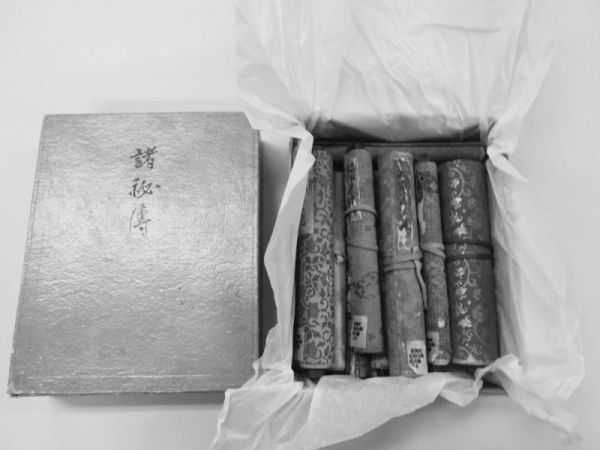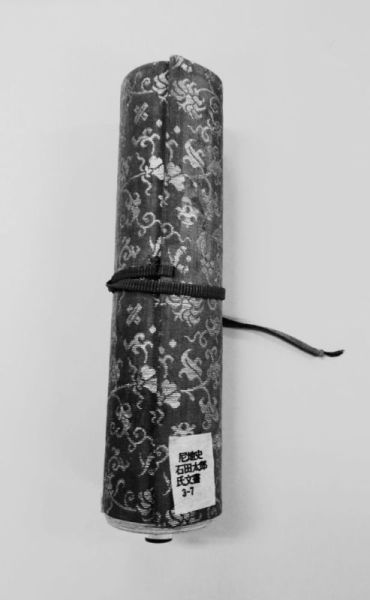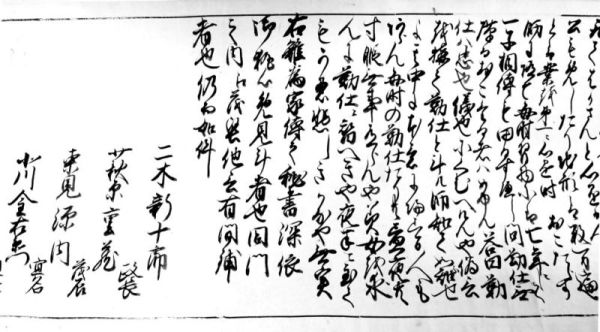5
THE MUBYŌSHI RYŪ CURRICULUM
Without doubt, much of Mubyōshi Ryū and the teachings of its founders have been lost, leading to an abstract feeling when trying to envision the school as a whole. However, inside the Ishida Tarō collection currently in the Amagasaki Municipal Archives (尼崎市立地域研究史料館) is a scroll named within its internals as Mubyōshi Ryū Kaimokusho. In the collection, however, the scroll is listed under the title Mubyōshi Ryū Heihō Hidensho (The secret military skills of Mubyōshi Ryū). This scroll was written by Mizuno Jūzō Mitsutoyo with the aim of compiling a complete list of the skills and elements of the school. Therefore, this scroll is considered a treasure in discovering the history of Mubyōshi Ryū because it gives a step-by-step account of the school’s contents and the levels within the teachings.

Figure 5.1. The Ishida Tarō collection of scrolls, including Mubyōshi Ryū Kaimokusho, now in the Amagasaki Municipal Archives (尼崎市立地域研究史料館蔵石田太郎氏文書)
A paraphrasing of the scroll is given below for ease, but note that in the original writing the skills for each section were listed with their titles. Here they have been removed, and in their place the number of skills has been given. This scroll includes not only the skill lists of physical abilities, such a grappling and chain weapons, but also a list of the oral traditions (kuden) alongside a catalog of the scrolls that make up the school’s body of work. The oral traditions list is given in full in chapter 16.

Figure 5.2. The Mubyōshi Ryū Kaimokusho of the Ishida Tarō collection
The list of scrolls are those that were in the school at the time of writing in 1786. It is noteworthy that many of the oral traditions from the kuden list appear in later scrolls like Mizukagami Kuden no Oboe and Mizukagami Shinsatsu, both of which were written well after the founder and are clearly collections of the school’s oral traditions—they have been translated in full in this book, which means that some of the oral traditions have been recorded. Therefore, allow the following lists to give a clearer overview of the ways of this medieval school. Be aware that some sections do not have direct English translations, as without context, there is too much potential for error.
The prologue and epilogue of the Kaimokusho scroll have not been translated in full, but the following is an overview of their contents.
THE PROLOGUE
The prologue includes a description of the origin and principles of the universe and the superiority of human beings to other living creatures. It states that only human beings are of perfect existence, representing heaven and earth, thus there should be nothing humans are not capable of. Samurai should learn multiple arts and principles, but all should be based on command of their bodies and limbs and freedom of movement.
Intellectual knowledge is essential for samurai, but first they have to train themselves to move freely to take advantage of the knowledge in actual fighting.
The school Mubyōshi Ryū has accumulated a number of scrolls that incorporate various skills, and they have been copied into this one scroll, which is named Kaimokusho. This is done to transmit these skills to the students of future generations.
It discusses the concept of studying principle over skills and techniques, and states that while many other schools study the concept of rhythm and no-rhythm, without knowing the truest of principles (that is, free movement over technique), a student will never reach achievement. Also, the teaching of no-sword will not work if you learn with an inappropriate teacher.
In Mubyōshi Ryū, you should not try to gain victory but instead concentrate on not being defeated. After focusing and training on this principle, a student will reach the truth of fighting. The difference between this school of Mubyōshi Ryū and others is this:
If you give priority to learning forms, your movement will stagnate. In training you should always train to attain free movement. Without it, you will get nowhere. If you keep training hard all the time throughout your life, you will defeat those who are not as good as you, but it does not allow you to win over your master because there are countless teachings to learn. However, constant training will surely lead to improvement, year by year and day by day.

Figure 5.3. The epilogue to the Kaimokusho scroll (尼崎市立地域研究史料館蔵石田太郎氏文書)
THE EPILOGUE
The main duty of teachers is to inherit their predecessor’s teachings and pass them on to their students in order to transmit the skills for generations. Teachers, if asked a lot of questions by students, should answer as much as possible, but there are hints on how to deal with the differing types of students.
• Those students who ask a lot of questions but who are not eager to train should not be given secrets.
• To those who train hard, you should give answers to all their questions. Teachings and training are both indispensable.
• Shūshin (enthusiasm) consists of donating gold and silver and treasures, thus do not hesitate to transmit anything to them as offering treasured items shows their seriousness.
• Those who are poor. If they are enthusiastic and dedicated to follow their teacher, you should transmit teachings. Money does not matter in this situation.
• Those who always train hard and learn from the teacher should be allowed to have isshisōden (full transmission) after seven years of hard training.
• Those who are busy with their official duties. Remember that official duties are priorities, but if you find they are lying and are only making excuses, do not chastise them. They may realize themselves some day and return to the correct way.
This is the end of the epilogue to the Kaimokusho scroll.
The following is the complete list of skills and scrolls found in the Kaimokusho scroll. The skill names have been removed and their number inserted. This constitutes the bulk of Mubyōshi Ryū’s teachings.
SECTION OF SKILLS (業之部, WAZA NO BU)
[The following skills are those which are used in Mubyōshi Ryū.]
Mubyōshi Ryū Part One (無拍子流前, mubyōshi ryū mae)
20 skills
Mubyōshi Ryū Part Two (無拍子流裏, mubyōshi ryū ura)
20 skills
Mubyōshi Ryū Basic Level (無拍子流真, mubyōshi ryū shin)
20 skills
Mubyōshi Ryū Mastery Level (無拍子流草, mubyōshi ryū sō)
20 skills
Mubyōshi Ryū Applications (無拍子流行, mubyōshi ryū gyō)
20 skills
Mubyōshi Ryū Grappling (無拍子流立合, mubyōshi ryū tachiai)
15 skills
[Tachiai is normally associated with standing skills, but that may not be the case here.]
Mubyōshi Ryū Grappling Lower Part (無拍子流真, mubyōshi ryū shin)
15 skills
Mubyōshi Ryū grappling Higher Level (無拍子流奥, mubyōshi ryū oku)
15 ways
Middle Level (中通, nakadōri)
12 skills
The Scroll of Reflecting on the Mind (心鑑之巻, shinkan no maki)
33 articles
Jūjutsu skills (外之物勝負之巻, tonomono shōbu no maki)
33 articles
[Read as sotonomono shōki no maki in this lineage of Mubyōshi Ryū]
Sword Striking and Jūjutsu (組討太刀打之巻, kumiuchi tachiuchi no maki)
23 skills
[Skills missing]
The Scroll of Mounted Combat (馬上組討之巻, bajō kumiuchi no maki)
23 skills
[Skills missing]
抜身 (nukimi)
25 articles
[Skills missing]
Important Ways of Jūjutsu (腰廻り要法, koshimawari yōhō)
12 skills
[Skills missing]
Sodeoka Ryū Quarterstaff (袖岡流棒, sodeoka Ryū bō)
15 skills
Chain and Weight Part One (前乳切木, mae chigiriki)
9 skills
[Skills missing; some chain and weight skills still exist in the school.]
Truncheon Part One (前霞, mae kasumi)
9 skills
[Skills missing]
The Scroll of Rope (縄之巻, nawa no maki)
12 skills
[Skills missing]
The Scroll of Tools (道具巻, dōgu [no] maki)
11 tools
Chain and Weight and No-Sword (無刀乳切木, mutō chigiriki)
7 skills
[Skills missing]
Deeper Skills of the Chain and Weight (奥乳切木, oku chigiriki)
3 skills
[Skills missing]
Deeper Skills of the Truncheon (奥霞, oku kasumi)
4 skills
[Skills missing]
Quarterstaff Scroll (踏返巻, fumikaeshi [no] maki)
7 skills
[Skills missing; this is stated as oral tradition only.]
Sodeoka Ryū Quarterstaff (袖岡流棒免, sodeoka ryū bō men)
7 skills plus 2 skills
[Skills may have changed, but a version is recorded in this book.]
Distance in Combat between Swords (相寸離劔之次第, aisun riken no shidai)
[Missing]
Some skills have been omitted from the above. (外数手業有之畧ス, hoka kazu tewaza ari kore ryakusu)
List of Mubyōshi Ryū Oral Traditions (無拍子流口傳之部, mubyōshi ryū kuden no bu)
158 skills
[Some of these skills are passed down within this book in the magical texts and shinobi scrolls. The full list is found in chapter 16.]
THE VARIOUS SCROLLS AND WRITINGS OF MUBYŌSHI RYŪ (諸巻書物之部, SHO KAN SHOMOTSU NO BU)
[The following is considered a complete list of Mubyōshi Ryū scrolls at the time it was written. Some scrolls that have been added to this book, such as the Mizukagami Kuden no Oboe, were written later and therefore do not appear in this list. Others have been added by other masters.]
Antony Cummins says: Some of the following translations have been simplified because of problems with seated and standing combat, and have been translated as jūjutsu skills. For full translations of the titles see the list in appendix D.
Jūjutsu Skills (居捕巻, idori [no] maki)
[Skills appear in this book. Read as iho no maki in this lineage of Mubyōshi Ryū]
Jūjutsu Skills (立合之巻, tachiai no maki)
[Skills appear in this book.]
The Scroll of Chain and Weight (乳切木巻, chigiriki [no] maki)
[Missing]
The Scroll of Reflecting on the Mind (心鑑之巻, shinkan no maki)
[Scroll translated in this book.]
Jūjutsu Skills (勝負之巻, shōbu no maki)
[Skills appear in this book.]
The Scroll of Grappling (組討巻, kumiuchi [no] maki)
[Skills missing]
The Scroll of Sword Striking (太刀討巻, tachiuchi [no] maki)
[Skills missing]
Mounted Riding Scroll (馬上之巻, bajō no maki)
[Skills missing]
The Rope Skills Scroll (縄之巻, nawa no maki)
[Skills missing]
The Scroll of Tools (道具巻, dōgu [no] maki)
[Tools appear in this book, but some skills with the tools are not recorded.]
Yawara Jo Tradition (流儀和序, ryūgi yawara jo)
[Short introduction for the school’s combat system, translated in this book]
付り追伽
[Missing; unknown scroll and reading]
The Water-Mirror Scroll (水鏡巻, mizukagami [no] maki)
[Skills of the shinobi, translated in this book]
毘沙門傳 (bishamonden)
[Possibly missing; foundation version to the following scroll. The following scroll appears to be extracts from this scroll, but it is unknown how big or comprehensive the original is. Clearly it is of great importance to the school.]
Teachings from the Deity Bishamonden (毘沙門傳抜書, bishamonden nukigaki)
[Translated in this book]
武用鑑 (buyō kagami)
[Missing]
筈動劔 (katsudō ken)
[Missing and unknown]
The Correct Mind of the Warrior (武士真直, bushi shinchoku)
[Missing]
The Scroll for Assisting in Ritual Suicide (介錯巻, kaishaku [no] maki)
[Skills appear in this book.]
The Scroll of the Star Hagun (破軍巻, hagun [no] maki)
[Skills appear in this book.]
The Nine Spell Ritual (九字, kuji)
[Skills appear in this book.]
The Ten Spell Ritual (十字, jūji)
[Skills appear in this book.]
Protection Scroll (護身法, goshinpō)
[Skills appear in this book.]
The Scroll of the Immovable Mind (不動心巻, fudōshin no maki)
[Missing]
免之巻 (men no maki)
[Missing]
同哥巻 (dōka [no] maki)
[Most likely this scroll’s title has a transcription error or uses other characters. The reading dōka can be read as “poems about the arts.” This could be The Scroll of Poems (歌之巻, uta no maki), which has been translated in this book.]
The Scroll of the Quarterstaff (棒之巻, bō no maki)
[Missing]
[Missing]
玉鍼巻 (tama hari [no] maki)
[Missing]
檟之巻 (hisagi no maki)
[Missing; possibly The Scroll of the Altar (壇之巻)]
Battle Fan Scroll (軍扇巻, gunsen [no] maki)
[Missing]
踏返巻 (fumikaeshi [no] maki)
[Missing]
Expelling the Spirit of the Fox Scroll (狐落巻, kitsune otoshi [no] maki)
[Missing]
There are thirty-three scrolls listed above which make up the teachings of the school. (以上三拾三巻)
List of Deep Secrets (極秘傳授之部, gokuhi denju no bu)
41 articles
一子相傳之部不書之 (isshisōden no bu kore ni kakazaru)
[It is unknown which are recorded in this book and which are not.]
Teachings on Resourcefulness (指南知謀之部, shinan chibō no bu)
[Missing]
Here ends the Mubyōshi Ryū Kaimokusho scroll, which has given a wide-ranging overview of the school of Mubyōshi Ryū.